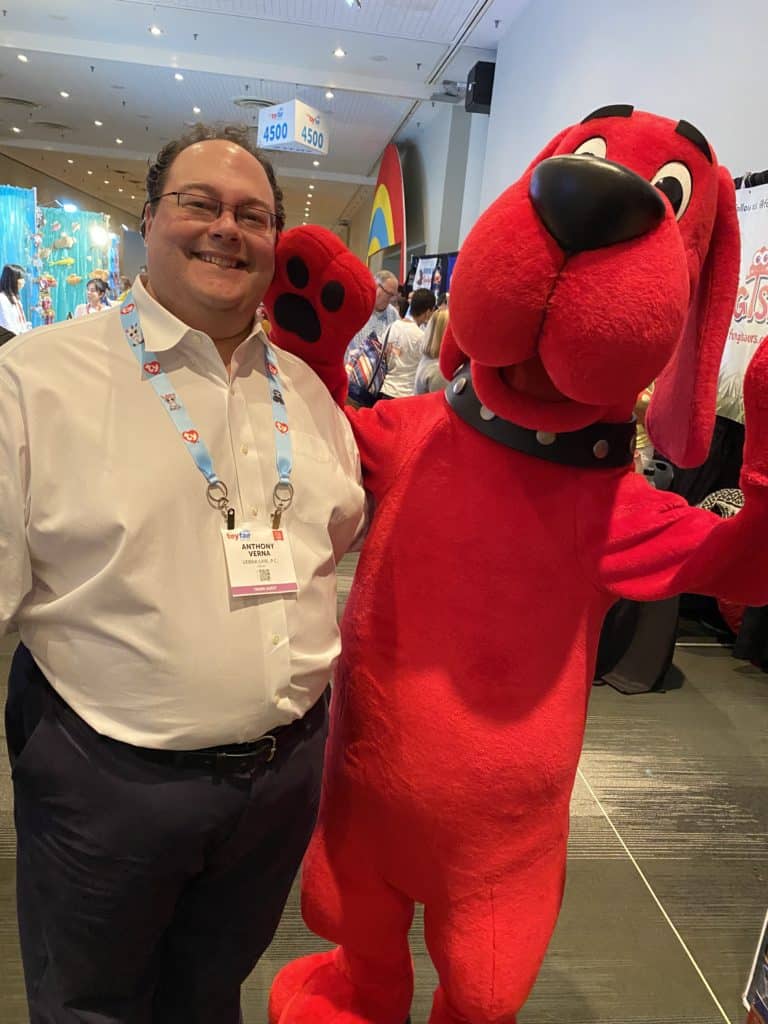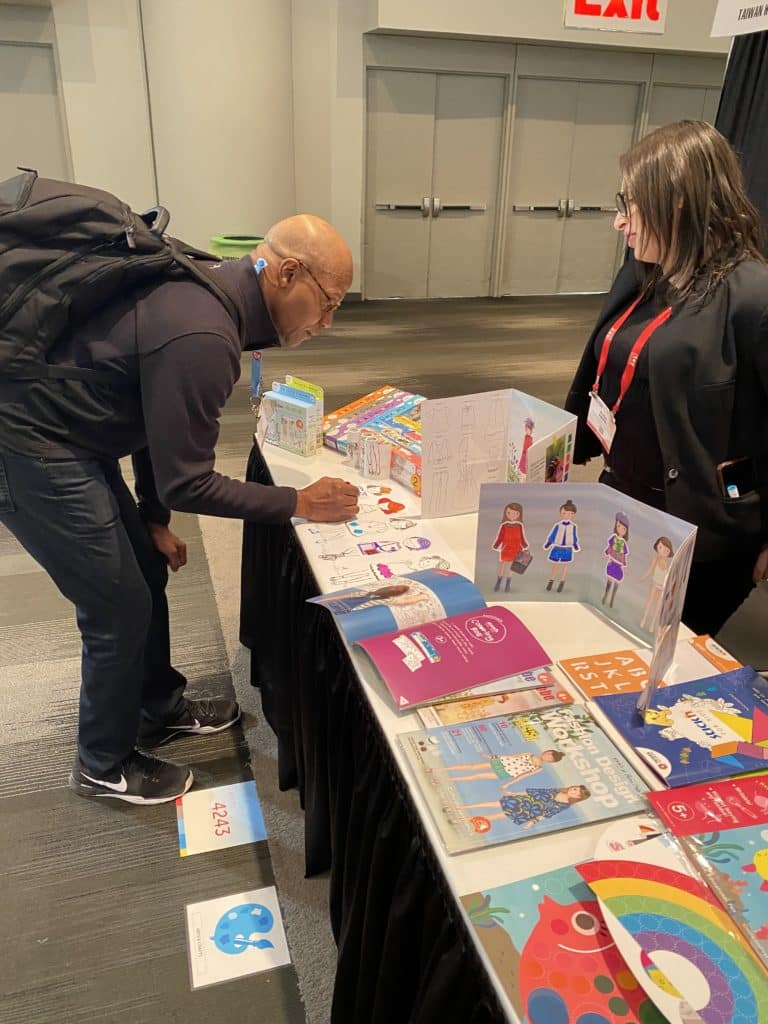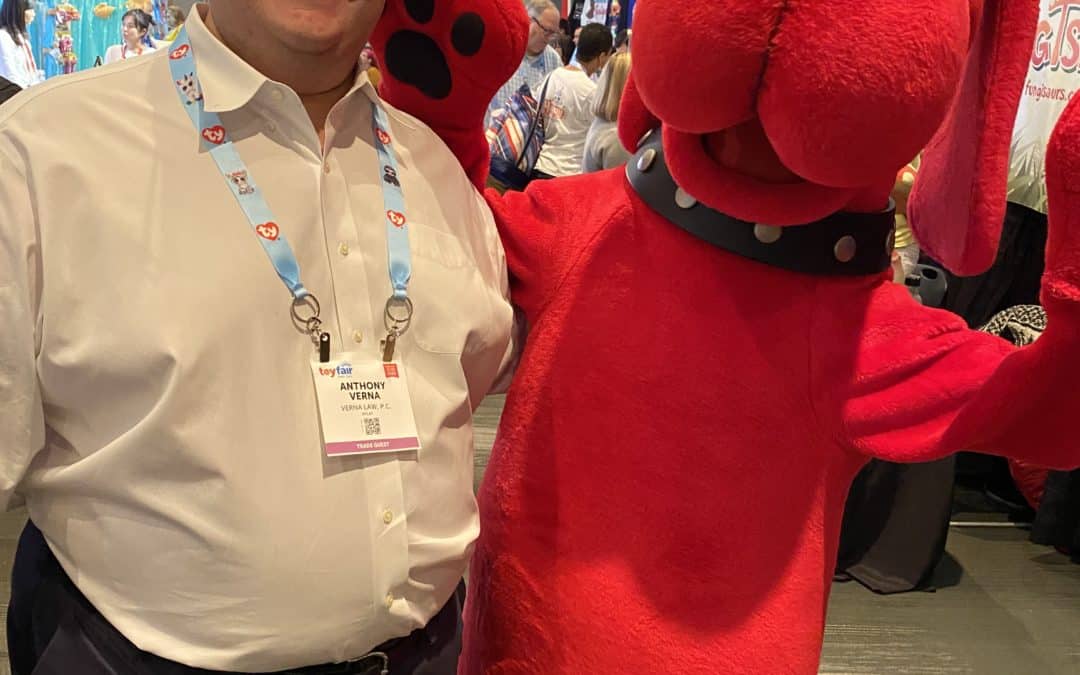Podcast: Play in new window | Download
Subscribe: Apple Podcasts | Email | RSS
Anthony Verna and Wil Jacques visited Toy Fair 2020. This is Anthony’s eleventh Toy Fair and Wil Jacques’ fifth Toy Fair. They opened the phone and recorded their thoughts for intellectual property trends they saw from the smaller businesses.

Anthony Verna:
Welcome to the “Law & Business” podcast. I’m Anthony Verna, Verna Law Managing
Partner.
Chances are that if you’re listening, you already knew that.
I am here at toy fair, 2020 with Wil Jacques, my patent agent.
Wil Jacques:
Good afternoon listening folks! Great to be here.
Anthony Verna:
All right, well, so let’s talk a few items, a few big idea items for intellectual property and toys.
One item that I noticed from maybe a patent side is the fact that there are plenty of companies that have patents filed, or at least they told us they had patents filed, but the patent is number is not noticed on the packaging. So let’s talk a little bit about what that means for them.
Wil Jacques:
Yeah. Kind of disturbing, actually, but, as you said, a lot
of companies claim that they had a few utility patents that were filed and or
issued.
But, the designation of those patents or markings were not on the packaging
that they had. And what I wanted to bring out to them is that it really plays
significantly or importantly in whether or not they were able and how much
damages they might be able to capture from market infringers if in fact they
never notified the market that the product that was being copied in fact had
patents on it.
And so that’s the whole idea of marking your product, with your patent numbers: so you send a signal to the market that if you copy this particular product, you’re copying one that’s already patent protected.
Anthony Verna:
I would also be worried from an infringement standpoint that, without giving notice of the number that a defendant would possibly have a complete defense to patent infringement anyway, because without that particular notice.
Wil:
It is onus on patent owners to notify any infringer, of copying
or infringing on their patents.
I mean, there’s, there’s no patent police, you know, there’s no one that goes
around to see whether or not people are actually infringing on your patent is
actually your responsibility to, to police that. So, you know, there are many
strategies that you need to employ. But one of the first strategies is you
can’t extract damages from someone until you notify them that they are actually
infringing on your patent.
Part of the marking of your product is a notification to the marketplace that you have a patented product.
Anthony Verna:
And, remember, “There is no patent police” is a trademark of
Wil Jacques, because if you listen to this podcast you have heard “There is no
patent police” at least 10 other times from, from Wil in past episodes.
So let’s talk about the utility versus design issue.
We spoke to several companies that said they had design
patents, but I think you and I probably wanted to try to push them a little
further to see if that design actually had utility.
Wil Jacques:
Yeah. Actually, it was very interesting conversation with a number of people that we talk to and, you know, again, in full disclosure and without disclosing what they were, telling us there were a number of companies that had what we thought to be utility features for their toys, their products, their inventions.
And for whatever reason they never sought, they never looked
into the opportunity to exploit the potential value of those utility, of
potential utility claims and those patents. And I was kind of surprised to hear
that there were various excuses, some around cost and what it would potentially
cost to do something like that, which can be somewhat erroneous. It’s almost
like asking how much is a brain surgery going to cost before you get, before
you get the x-ray.
And so, you know, we had an opportunity to at least explain that. But the other
thing, and even more importantly, was that they had an incorrect thought about
what these features they had would be in a utility patent. In other words, they
have elements that they knew were known, but what they didn’t realize is that
they were putting those things together and they were having them function. And
what we might consider just off the top at this show is being something that
was novel and different from what would have been in the prior art as it
existed now.
Anthony:
So I think that’s a real key for a lot of a lot of small companies. Make sure that you’re looking at the utility and not just the design. Patents are good, but utility patents are, are, are much better.
One item I certainly noticed was that a lot of companies said that they had filed their own trademark. And what, my caveat emptor to that is that you’re not doing due diligence. And if you’re not doing your due diligence, you’re not doing a trademark search. You’re not seeing what the, as one of my colleagues once said to me what the universe of that particular trademark is. You don’t know who your potential plaintiffs are for using the mark in commerce. A lot of companies don’t particularly see many potential plaintiffs when they do the trademark search. But, if you do the search and you see the speed bumps, you can figure out how to work your way around the speed bumps before they happen.

Wil:
It’s almost like a kind of head in the sand approach – and not that they mean to do that. But again, people are trying to avoid certain costs, that shouldn’t be avoided, you know, and then spending money in areas that maybe they should take a back seat and review.
As an example: with the trademark stuff, they will invest a significant amount of money in logos and branding and other work try to separate themselves in the marketplace. Only defined two or three years later, maybe earlier, once they start making a few bucks, that the folks that they should have caught on to very early on in the search are now knocking on their doors saying that they are infringing on their trademarks. And brands.
Anthony:
Right.
So I think that, I think that’s a real key. Also, uh, starting early with your trademarks is important because getting that, that registration before an infringement occurs is very important in trademark law.
And you heard me talk about that in a previous video blog where a settlement for a trademark infringement wasn’t as high as we had hoped in one case. But that’s because the infringement happened before the registration did.
Another issue that I see is that a lot of companies are basically taking a license agreement from a licensor; not having counsel review it and also therefore just kind of accepting it.
Two issues I have with that one. Apart from the fact that I
think it’s important to have council review any agreement that accompany
entries into so that you understand what every word means, what every paragraph
means, and how that fits into the whole agreement to begin with so that a
company knows its liabilities and its duties under their contract.
But also there might be even with a market difference between a small company
and one of these big licensers, there still might be room for negotiation of
terms, especially with counsel.
We have ways of negotiating.
It could be that sometimes you need to be a stone wall and you need to say, “No, my client draws the line here.” And sometimes you pick up the phone, you say, “You know, I know you guys are big but my guys small and we kind of need a favor and here’s what the favor is.”
Now, look, I’m not going to sit here and tell you that, that
all agreements have wiggle room. I’m not going to tell you that any one
particular method of negotiation is better than the other. But without counsel
there, I don’t particularly think you’re even to get something better on the
license.
Wil:
They actually leave money on the table. They may have as a part of their patent portfolio.
Let’s say a utility patent that involves, so a system and a method or particular software, you know, that kind of drives, uh, mechanisms, certain toy features a physical apparatus associated with their portfolio and they will license the entire thing, not only the toy, the design, and the mechanical parts of their patent portfolio, but also just kind of without thinking about and also license the software segment of that. Not realizing that the software is where the dollars are probably generated more so than on the toy itself because it may be recurring.
For instance, there are companies out here that are updating
and writing new stories associated with a product that they may have, but the
new story is actually being downloaded through an app that’s connected to that
product. Well, they’re losing revenue on that. If you’re only licensing on the
physical product side and ignoring the recurring revenue that’s occurring from
the marketplace users actually downloading and using the app. So you want to
have counsel, you want to have professionals take a look at these deals, take a
look at these license agreements to make sure you’re at least extracting value
from each and every component of the potential IP portfolio. And not always
looking at it as one patent as a whole.
Anthony Verna:
I think that’s very important from the licensor standpoint, Wil, so thank you. Thank you for that. We are, since Toy Fair is letting out here, I think we’re going to get rolling since we’re used to recording in a studio, a with real microphones and not on our iPhones. But, uh, Hey, technology is amazing.
Wil:
We totally improvise and we end up when we meet to.
Anthony:
Oh, I love you, my friend. Thank you for listening to this mini episode of the “Law and Business” podcast. I’m Anthony Verna. I’m here with Wil Jacques. Okay. Good night folks. We’ll see you soon. Thank you.


Trackbacks/Pingbacks